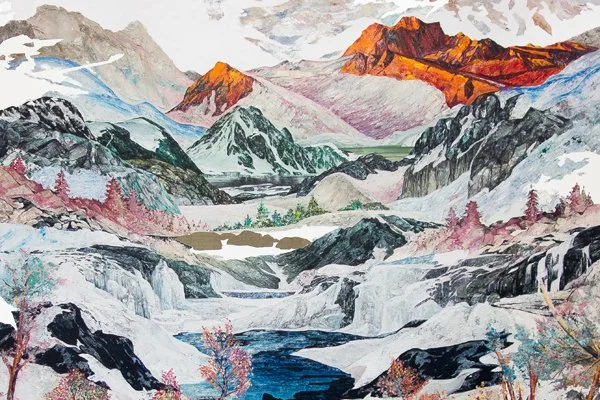
Irene Grau
Irene Grau's oeuvre speaks of painting and landscape, of process and displacement through rigorous research into the possibilities of monochrome painting and its relation to landscape as both genre and framework, but above all as experimentation; as a way of seeing.
Landscape painting that is carried out in the landscape itself preoccupied artists such as Vincent Van Gogh or Paul Cézanne -who might have pioneered a pictorial nomadism of sorts-, but was already an object of study for Courbet, Constable, or Turner. Impressionism was however the first style to work somewhere in between an image and a painting. Whilst Manet managed to get rid of the connection between narrative and spatial depth, Monet abandoned the use of drawing as a way of priming color, dissolving the horizon and blurring the landscape; abandoning the referent. If there is one thing that modern painting aspired to, it was to highlight the materiality of the pigment. Brushstrokes are fragmented, while the areas left empty allow for the brushstrokes to appear in no way final. It is only by looking back that we can guess the origin of, for example, Günther Förg's last paintings. And it is also through knowledge of the past and of art history that these conceptually parallel projects of Irene Grau's gain significance and move forward in the contemporary redefinition of the landscape genre, as well as the idea of displacement, a core concept in her art practice.
- David Barro
Spanish artist Irene Grau (born 1986 in Valencia) lives and works in Santiago de Compostela. Grau’s methodology focuses on color as a transforming agent of space, and its perception. A meticulous analysis of an in situ intervention and its transformation through color is quasi-ubiquitous in her work - an approach in the tradition of radical monochromatic painting, as well as mural painting, performative process, and landscape - the latter in a broad sense. The title of her recent doctoral thesis, The Painter on the Road, perfectly sums up her interest and attitude toward the medium of painting, and Irene Grau’s process could perfectly be described as a conceptual pleinairist, who states that her work is "what remains" of a wider experience, going far beyond the physically traveled landscape or an explored architectural structure. Solely transmitting an experience may well lack of concrete information, yet her work leaves enough clues to the viewer to allow access through process, intervention, and the document thereof, in order to visually and conceptually understand the artist’s modus operandi and artistic questioning and concerns.
In 2010 she was the recipient of an Academic Excellence Scholarship, followed by a 2011-2015 FPU Fellowship from the Spanish Ministry of Education, Culture and Sport, allowing her to pursue her doctoral studies. She received her PhD in Fine Arts from the Polytechnic University of Valencia in 2016.
Grau is a recent recipient of the Premio Generaciones, one of the most prestigious Prizes in Spain, accompanied by an exhibition at La Casa Encendida in Madrid. Her work was also included in in the exhibition projects Minimal Gestures at Galerie Heike Strelow in Frankfurt, Germany; and Bajo el brazo. Entre la palma de la mano y la axila at the CaixaForum in Barcelona, Spain. In 2018 she had solo exhibitions at Atelier Fidalga, in São Paulo, Brazil; and at Robert Henry Contemporary in Bushwick / Brooklyn, New York and at didac.gal (DIDAC), in Santiago de Compostela, Spain.
Grau’s recent exhibition construction season at the Madison Museum of Contemporary Art in Madison, Wisconsin, was her first one person Museum exhibition in the US.
Spanish artist Irene Grau lives and works in Santiago de Compostela, a significant city in Spanish and European history: It’s the end of the Camino de Santiago pilgrimage route. Fittingly, last year in Madrid, she staged the exhibition “Lo que importaba estaba en la línea, no en el extremo (What mattered was in the line, not in the extreme),” a phrase she borrowed from a work of fiction by Argentine writer César Aira. For the conceptual artist, that line could be history, the personal or cultural journey that leads to now and beyond.
(…)
click on ARTSY logo to read the full article and interview with Irene Grau.
Exhibitions
-

IRENE GRAU: TRAVELING EXHIBITION
September 1 - October 30, 2021
-

IRENE GRAU: INCOHERENT WALK
January 7 - March 16, 2019
Abroms-Engel Institute for the Visual Arts, AEIVA, Birmingham, Alabama
-

IRENE GRAU: CONSTRUCTION SEASON
May 5 - August 5, 2018
Madison Museum of Contemporary Art, MMoCA, in Madison, Wisconsin
-

IRENE GRAU: #
November 10 - December 22, 2017
-

TERRENO ASPERO | RUGGED TERRAIN
October 21 - December 30, 2016
-

IRENE GRAU: ▲
November 4 - December 18, 2015
Publications
-

IRENE GRAU
published by Maus Contemporary
september 2018
22 by 15,6 cm (approx. 8.6 by 6.1 in.)
with texts by Ángel Calvo Ulloa, Álvaro Negro, Enrique Vila-Matas, Brett M Levine, and Irene Grau.English, Spanish
softback, 216 pages, full color
isbn: 978-84-92772-62-9
-

IRENE GRAU: CONSTRUCTION SEASON
by Leah Kolb, published by the Madison Museum of Contemporary Art to accompany Irene Grau’s exhibition at the Madison Museum of Contemporary Art,MMoCA, May 5 to August 5, 2018, in Madison, Wisconsin, with an essay by Spanish art critic Mónica Maneiro
september 2018
dimensions!!!!!!!!!!!!
111 pages, ??????hardcover
isbn: 978-0-91388342-6
-

terreno áspero | rugged terrain
published by the Maus Contemporary to accompany the exhibition terreno áspero | rugged terrain - five contemporary artists from Spain, October 21 to December 30, 2016 at Maus Contemporary; with essays by Spanish art critic Ángel Calvo Ulloa and American art critic Brett Levine.
october 2016
softcover64 pages, full color, 10 by 8 in. (ca. 25,4 by 20,3 cm)
-

IRENE GRAU: GOING OUT IN SEARCH OF PAINTING
published by Irene Grau in a limited edition of 300 numbered and signed copies
october 2015
21 by 14,8 cm (approx. 8.3 by 5.8 in.)
with a text by Ángel Calvo UlloaEnglish, Spanish
saddle stitch bound softcover, 14 pages, full color

